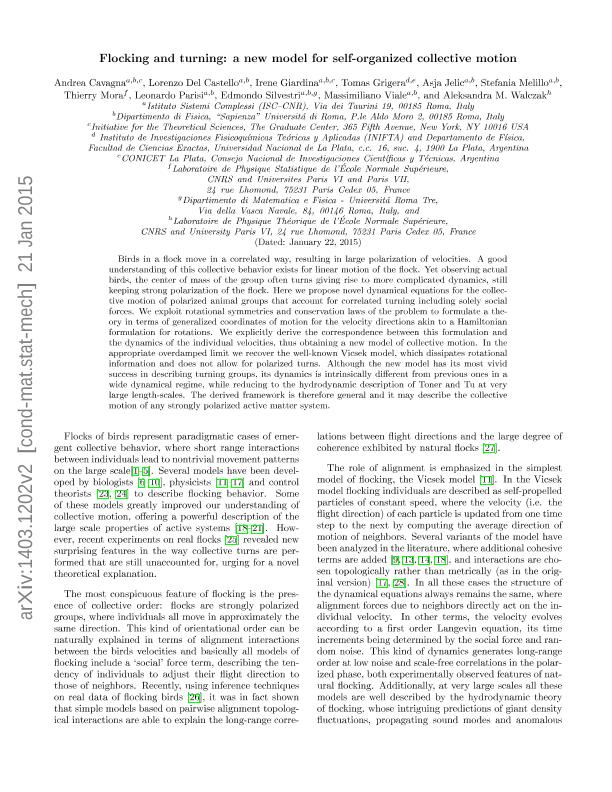Artículo
Flocking and turning: a new model for self-organized collective motion
Cavagna, Andrea; del Castello, Lorenzo; Giardina, Irene; Grigera, Tomas Sebastian ; Jelic, Asja; Melillo, Stefania; Mora, Thierry; Parisi, Leonardo; Silvestri, Edmondo; Viale, Massimiliano; Walczak, Aleksandra M.
; Jelic, Asja; Melillo, Stefania; Mora, Thierry; Parisi, Leonardo; Silvestri, Edmondo; Viale, Massimiliano; Walczak, Aleksandra M.
 ; Jelic, Asja; Melillo, Stefania; Mora, Thierry; Parisi, Leonardo; Silvestri, Edmondo; Viale, Massimiliano; Walczak, Aleksandra M.
; Jelic, Asja; Melillo, Stefania; Mora, Thierry; Parisi, Leonardo; Silvestri, Edmondo; Viale, Massimiliano; Walczak, Aleksandra M.
Fecha de publicación:
27/09/2014
Editorial:
Springer
Revista:
Journal Of Statistical Physics
ISSN:
0022-4715
Idioma:
Inglés
Tipo de recurso:
Artículo publicado
Clasificación temática:
Resumen
Birds in a flock move in a correlated way, resulting in large polarization of velocities. A good understanding of this collective behavior exists for linear motion of the flock. Yet observing actual birds, the center of mass of the group often turns giving rise to more complicated dynamics, still keeping strong polarization of the flock. Here we propose novel dynamical equations for the collective motion of polarized animal groups that account for correlated turning including solely social forces. We exploit rotational symmetries and conservation laws of the problem to formulate a theory in terms of generalized coordinates of motion for the velocity directions akin to a Hamiltonian formulation for rotations. We explicitly derive the correspondence between this formulation and the dynamics of the individual velocities, thus obtaining a new model of collective motion. In the appropriate overdamped limit we recover the well-known Vicsek model, which dissipates rotational information and does not allow for polarized turns. Although the new model has its most vivid success in describing turning groups, its dynamics is intrinsically different from previous ones in a wide dynamical regime, while reducing to the hydrodynamic description of Toner and Tu at very large length-scales. The derived framework is therefore general and it may describe the collective motion of any strongly polarized active matter system.
Palabras clave:
Flocking
,
Active Matter
,
Collective Behavior
,
Emergent Behavior
,
Animal Groups
Archivos asociados
Licencia
Identificadores
Colecciones
Articulos(INIFTA)
Articulos de INST.DE INV.FISICOQUIMICAS TEORICAS Y APLIC.
Articulos de INST.DE INV.FISICOQUIMICAS TEORICAS Y APLIC.
Articulos(SEDE CENTRAL)
Articulos de SEDE CENTRAL
Articulos de SEDE CENTRAL
Citación
Cavagna, Andrea; del Castello, Lorenzo; Giardina, Irene; Grigera, Tomas Sebastian; Jelic, Asja; et al.; Flocking and turning: a new model for self-organized collective motion; Springer; Journal Of Statistical Physics; 158; 3; 27-9-2014; 601-627
Compartir
Altmétricas



